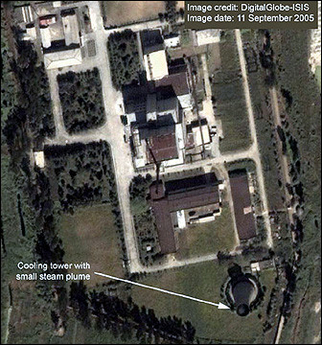|
Photos released of activity at N.Korean reactor sites
(AFP)
Updated: 2005-09-15 08:53
A US thinktank with ties to the diplomatic and intelligence communities released a satellite photograph which it said showed North Korea had resumed operating a five-megawatt nuclear reactor, AFP reported.
The Washington-based Institute for Science and International Security (ISIS) displayed on its web site a satellite picture of the reactor at Yongbyon, North Korea's main nuclear complex north of the capital Pyongyang.
The ISIS said the photo shows "a steam plume from the cooling tower" of the reactor. "This plume indicates that the reactor is operating," the ISIS said in a statement.

This new satellite image released by Digitalglobe shows the 5 MWe nuclear reactor at Yongbyon, North Korea, 11 September, 2005. [AFP] |
The institute also released a new satellite photograph of a 50-megawatt reactor construction site at Yongbyon which it said showed "new activity, though not the resumption of large-scale construction."
It pointed to a new road surface and what it described as a "new object, possibly a mobile crane."
The photos can be viewed online at www.isis-online.org.
Their release came as North Korea, South Korea, Japan, China, Russia and the United States held another round of talks in Beijing on North Korea's nuclear program.
The talks are aimed at persuading North Korea, which expelled international monitors and now says it has nuclear weapons, to give up the bomb in exchange for security guarantees as well as energy and economic aid.
Negotiations have been bogged down over North Korea's demand for peaceful nuclear energy, a demand resisted by Washington which has said it cannot be trusted.
A Japanese daily, Asahi Shimbun, reported last month that North Korea had reactivated the five-megawatt nuclear reactor at Yongbyon in July, just ahead of a previous round of the six-party talks.
In April, North Korea said it had shut down the reactor, 90 kilometers (50 miles) north of Pyongyang, while it was preparing to reprocess more spent fuel, a move that could result in the production of enough plutonium to double its nuclear arsenal.
|